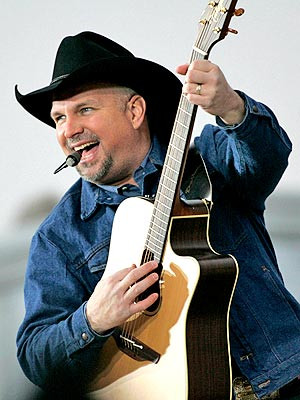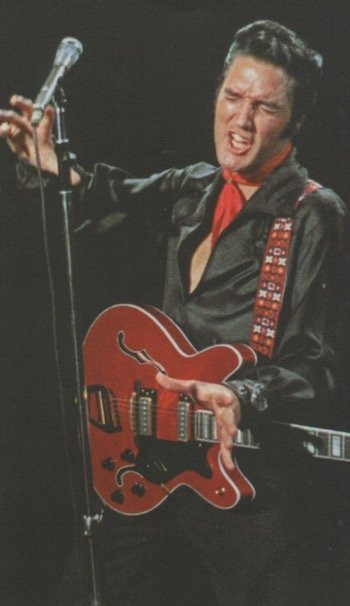Garth Brooks, a name synonymous with country music stardom, might seem worlds apart from the King of Rock and Roll, Elvis Presley. Yet, the emotional resonance of Brooks’s signature song, “The Dance,” offers a surprisingly poignant lens through which to view Elvis’s relationship with his fans. While initially skeptical of comparisons between Garth Brooks’ concert excitement and Elvis’s legendary performances, the sheer magnitude of Brooks’s Spokane show – selling 84,000 tickets in a mere 90 minutes – underscored the powerful connection artists can forge with their audience. This phenomenon prompted a deeper reflection on how Brooks’s heartfelt ballad, “The Dance,” captures the essence of the enduring and evolving bond between Elvis and his devoted followers.

Image of Garth Brooks performing live, highlighting the energy and connection he shares with his audience, mirroring the passionate fanbase of Elvis Presley.
To understand this connection, let’s delve into the evocative lyrics of “The Dance,” penned by Tony Arata:
“Looking back on the memory of the dance we shared ‘neath the stars above,
For a moment all the world was right.
How could I have known that you’d ever say goodbye.”
“And now I’m glad I didn’t know the way it all would end, the way it all would go.
Our lives are better left to chance.
I could have missed the pain, but I’d have had to miss the dance.”
These lyrics, seemingly about lost love, resonate deeply when considered as a metaphor for the ebb and flow of Elvis Presley’s relationship with his fans across different eras. It’s not a literal interpretation, but rather a figurative exploration of the shared experiences and emotional journey between an icon and his admirers.
Elvis and His Fans: A Metaphorical Dance Through the Years
Elvis’s career wasn’t a static phenomenon; it was a series of evolving phases, each attracting and engaging different segments of fans. Like “dances,” these periods represent unique moments in time where Elvis and his audience connected in distinct ways.
The First Dance: The Initial Spark of Fandom (1954-1955)
The earliest fans were captivated by the raw energy of Elvis’s Sun Records and his appearances on shows like the Louisiana Hayride. These were nascent moments, small sparks of fandom ignited in the Southern states as Elvis’s unique sound began to spread through radio airwaves. This initial “dance” was intimate and regional, a precursor to the national phenomenon to come.
The Second Dance: Nationwide Craze and Phenomenal Growth (1956-1957)
The mid-1950s witnessed Elvis explode onto the national scene. Over 100 live performances across the country, Hollywood movie debuts, and groundbreaking television appearances brought Elvis directly into American homes. This era was a whirlwind “dance” of mass hysteria and unprecedented fandom, solidifying Elvis as a cultural icon.
The Third Dance: Maturation and Pop Stardom (1960s)
Emerging from his army service in 1960, Elvis presented a more mature, polished pop star persona. While this era brought hits like “Return to Sender” and films like Girls! Girls! Girls!, it also marked a shift in his fanbase. Some original rock and roll enthusiasts felt left behind by this “tamed” Elvis, while a new generation embraced his movie star image and softer musical style. This “dance” was about evolution and adaptation, attracting new followers while inevitably losing some from the previous era.

Image from Elvis Presley’s ’68 Comeback Special, representing his return to raw performance energy and a shift in his career, captivating both old and new fans.
The Fourth Dance: Vegas and the Concert King Era (1970s)
Elvis’s 1970s comeback saw him conquer Las Vegas and embark on extensive national tours. This “dance” was characterized by зрелищность and зрелость. His audience now included many adults, some revisiting their youthful fandom, others discovering Elvis anew. This era was a testament to his enduring appeal and performance prowess, solidifying his status as the “King” in a different, more mature context.
The Enduring Dance: Legacy and Posthumous Fandom (Post-1977)
Even after his passing in 1977, Elvis’s “dance” with fans continues. New generations discover his music and legend, ensuring his legacy endures. This final “dance” is about timeless appeal and the power of music to transcend generations, keeping Elvis relevant for audiences who never even saw him perform live.
The Pain and the Dance: Imperfection and Enduring Love
Just as “The Dance” lyrics acknowledge the potential for pain in love, Elvis’s relationship with his fans wasn’t without its complexities. Fans experienced disappointment as Elvis’s career and personal life evolved. His army service, his foray into Hollywood, and later, his personal struggles, all presented moments where fans felt a sense of distance or even disillusionment. Learning about Elvis’s imperfections was a “painful” process for many who had placed him on a pedestal.
However, like the song suggests, “I could have missed the pain, but I’d have had to miss the dance.” The joy, excitement, and deep connection experienced through Elvis’s music and performances outweighed the inevitable disappointments. The “dance” – the shared journey between Elvis and his fans – was worth the occasional heartache. The enduring power of Garth Brooks’ “The Dance” lyrics lies in their ability to capture this bittersweet truth: that profound connections, whether in love or fandom, are precious precisely because they are fleeting and sometimes painful, but ultimately, immeasurably worthwhile.
